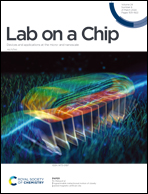Microfabrication-based engineering of biomimetic dentin-like constructs to simulate dental aging†
Abstract
Human dentin is a highly organized dental tissue displaying a complex microarchitecture consisting of micrometer-sized tubules encased in a mineralized type-I collagen matrix. As such, it serves as an important substrate for the adhesion of microbial colonizers and oral biofilm formation in the context of dental caries disease, including root caries in the elderly. Despite this issue, there remains a current lack of effective biomimetic in vitro dentin models that facilitate the study of oral microbial adhesion by considering the surface architecture at the micro- and nanoscales. Therefore, the aim of this study was to develop a novel in vitro microfabricated biomimetic dentin surface that simulates the complex surface microarchitecture of exposed dentin. For this, a combination of soft lithography microfabrication and biomaterial science approaches were employed to construct a micropitted PDMS substrate functionalized with mineralized type-I collagen. These dentin analogs were subsequently glycated with methylglyoxal (MGO) to simulate dentin matrix aging in vitro and analyzed utilizing an interdisciplinary array of techniques including atomic force microscopy (AFM), elemental analysis, and electron microscopy. AFM force-mapping demonstrated that the nanomechanical properties of the biomimetic constructs were within the expected biological parameters, and that mineralization was mostly predominated by hydroxyapatite deposition. Finally, dual-species biofilms of Streptococcus mutans and Candida albicans were grown and characterized on the biofunctionalized PDMS microchips, demonstrating biofilm-specific morphologic characteristics and confirming the suitability of this model for the study of early biofilm formation under controlled conditions. Overall, we expect that this novel biomimetic dentin model could serve as an in vitro platform to study oral biofilm formation or dentin–biomaterial bonding in the laboratory without the need for animal or human tooth samples in the future.



 Please wait while we load your content...
Please wait while we load your content...